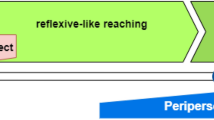Abstract
Biologically inspired robotics offers the promise of future autonomous devices that can perform significant tasks while coping with noisy, real-world environments. In order to survive for long periods we believe a developmental approach to learning is required and we are investigating the design of such systems inspired by results from developmental psychology. Developmental learning takes place in the context of an epigenetic framework that allows environmental and internal constraints to shape increasing competence and the gradual consolidation of control, coordination and skill. In this paper we describe the use of novelty and habituation as the motivation mechanism for a sensory-motor learning process. In our system, a biologically plausible habituation model is utilized and the effect of parameters such as habituation rate and recovery rate on the learning/development process is studied. We concentrate on the very early stages of development in this work. The learning process is based on a topological mapping structure which has several attractive features for sensory-motor learning. The motivation model was implemented and tested through a series of experiments on a working robot system with proprioceptive and contact sensing. Stimulated by novelty, the robot explored its egocentric space and learned to coordinate motor acts with sensory feedback. Experimental results and analysis are given for different parameter configurations, proprioceptive encoding schemes, and stimulus habituation schedules.
Preview
Unable to display preview. Download preview PDF.
Similar content being viewed by others
References
Arbib, M.A.: The Metaphorical Brain 2. J. Wiley, NY (1989)
Becker, J.: A Model for the Encoding of Experiential Information. In: Shank, R., Colby, K. (eds.) Computer Models of Thought and Language, pp. 396–435. Freeman, New York (1973)
Bernstein Nikolai, A.: The Co-ordination and Regulation of Movements. Pergamon Press, Oxford (1967)
Peter, B.R., James, F.R., Erann, G., David, K., Miller David, P., Slack Mark, G.: Experiences with Architecture for Intelligent, Reactive Agents. Journal of Experimental and Theoretical Artificial Intelligence 9(2), 237–256 (1997)
Bosco, G., Poppele, R.E., Eian, J.: Reference Frames for Spinal Proprioception: Limb Endpoint Based or Joint-Level Based? J. Neurophysiol. 83(5), 2931–2945 (2000)
Brooks, R.: Intelligence Without Representatio. Artificial Intelligence (1991)
Bruner, J.S.: Acts of Meaning. Harvard University Press, Cambridge (1990)
Churchland, P.S., Sejnowski, T.J.: The Computational Brain. MIT Press, Cambridge (1994)
Drescher, G.L.: Made up minds: a constructivist approach to artificial intelligence. MIT Press, Cambridge (1991)
Foner, L.N., Maes, P.: Paying Attention to What’s Important: Using Focus of Attention to Improve Unsupervised Learning. In: Proc. 3rd Int. Conf. Simulation of Adaptive Behaviour, Cambridge MA, pp. 256–265 (1994)
Hendriks-Jansen, H.: Catching Ourselves in the Act. MIT Press, Cambridge (1996)
Lee, M.H.: A Computational Study of Early Spatial Integration. In: Proc. 5th Int. Congress of Cybernetics and Systems, Mexico (1981)
Stephen, M., Ulrich, N., Jonathan, S.: Novelty Detection on a Mobile Robot Using Habituation. In: From Animals to Animats, The Sixth International Conference on Simulation of Adaptive Behaviour, Paris, pp. 189–198 (2000)
Newcombe Nora, S., Janellen, H.: Making Space. MIT Press, Cambridge (2000)
Nolfi, S., Floreano, D.: Evolutionary Robotics: The Biology, Intelligence, and Technology of Self-Organizing Machines. MIT Press/Bradford Books, Cambridge (2000)
Perl, J.: Fusion, propagation, and structuring in belief networks. Artificial Intelligence 29(3), 241–288 (1986)
Pfeifer, R.: On the role of morphology and materials in adaptive bahavior. In: Meyer, J.-A., Berthoz, A., Floreano, D., Roitblat, H., Wilson, S.W. (eds.) From animals to Animates 6. Proceedings of the sixth International Conference on Simulation of Adaptive Behavior 2000, pp. 23–32 (2000)
Piaget, J.: The Child’s Conception of the World, translated by J. Tomlinson and A. Tomlinson, Paladin, London (1973)
Stanley, J.C.: Computer simulation of a model of habituation. Nature 261, 146–148 (1976)
Thelen, E.: Grounded in the world: Developmental origins of the embodied mind. Infancy 1(1), 3–28 (2000)
Wang, D.: Habituation. In: Arbib, M.A. (ed.) The Handbook of Brain Theory and Neural Networks, pp. 441–444. MIT Press, Cambridge (1995)
Author information
Authors and Affiliations
Editor information
Editors and Affiliations
Rights and permissions
Copyright information
© 2005 Springer-Verlag Berlin Heidelberg
About this chapter
Cite this chapter
Meng, Q., Lee, M.H. (2005). Novelty and Habituation: The Driving Forces in Early Stage Learning for Developmental Robotics. In: Wermter, S., Palm, G., Elshaw, M. (eds) Biomimetic Neural Learning for Intelligent Robots. Lecture Notes in Computer Science(), vol 3575. Springer, Berlin, Heidelberg. https://doi.org/10.1007/11521082_19
Download citation
DOI: https://doi.org/10.1007/11521082_19
Publisher Name: Springer, Berlin, Heidelberg
Print ISBN: 978-3-540-27440-7
Online ISBN: 978-3-540-31896-5
eBook Packages: Computer ScienceComputer Science (R0)




